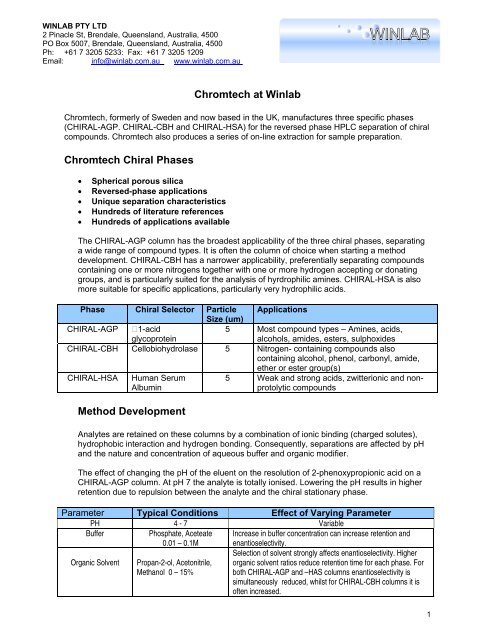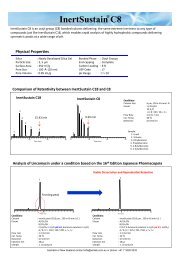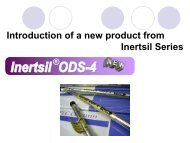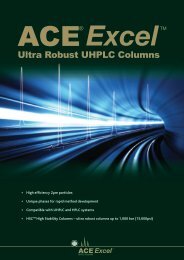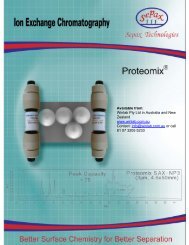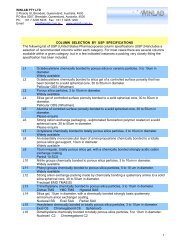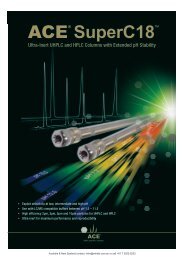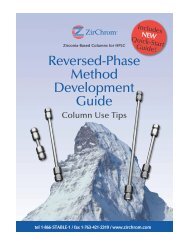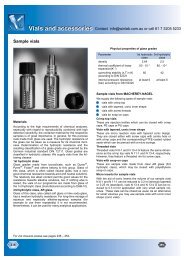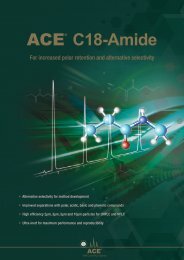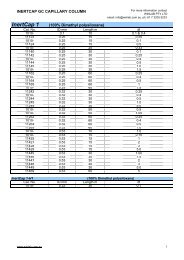Chromtech at Winlab Chromtech Chiral Phases ... - Winlab.com.au
Chromtech at Winlab Chromtech Chiral Phases ... - Winlab.com.au
Chromtech at Winlab Chromtech Chiral Phases ... - Winlab.com.au
You also want an ePaper? Increase the reach of your titles
YUMPU automatically turns print PDFs into web optimized ePapers that Google loves.
WINLAB PTY LTD<br />
2 Pinacle St, Brendale, Queensland, Australia, 4500<br />
PO Box 5007, Brendale, Queensland, Australia, 4500<br />
Ph: +61 7 3205 5233: Fax: +61 7 3205 1209<br />
Email: info@winlab.<strong>com</strong>.<strong>au</strong> www.winlab.<strong>com</strong>.<strong>au</strong><br />
<strong>Chromtech</strong> <strong>at</strong> <strong>Winlab</strong><br />
<strong>Chromtech</strong>, formerly of Sweden and now based in the UK, manufactures three specific phases<br />
(CHIRAL-AGP. CHIRAL-CBH and CHIRAL-HSA) for the reversed phase HPLC separ<strong>at</strong>ion of chiral<br />
<strong>com</strong>pounds. <strong>Chromtech</strong> also produces a series of on-line extraction for sample prepar<strong>at</strong>ion.<br />
<strong>Chromtech</strong> <strong>Chiral</strong> <strong>Phases</strong><br />
<br />
<br />
<br />
<br />
<br />
Spherical porous silica<br />
Reversed-phase applic<strong>at</strong>ions<br />
Unique separ<strong>at</strong>ion characteristics<br />
Hundreds of liter<strong>at</strong>ure references<br />
Hundreds of applic<strong>at</strong>ions available<br />
The CHIRAL-AGP column has the broadest applicability of the three chiral phases, separ<strong>at</strong>ing<br />
a wide range of <strong>com</strong>pound types. It is often the column of choice when starting a method<br />
development. CHIRAL-CBH has a narrower applicability, preferentially separ<strong>at</strong>ing <strong>com</strong>pounds<br />
containing one or more nitrogens together with one or more hydrogen accepting or don<strong>at</strong>ing<br />
groups, and is particularly suited for the analysis of hyrdrophilic amines. CHIRAL-HSA is also<br />
more suitable for specific applic<strong>at</strong>ions, particularly very hydrophilic acids.<br />
Phase <strong>Chiral</strong> Selector Particle Applic<strong>at</strong>ions<br />
Size (um)<br />
CHIRAL-AGP 1-acid<br />
glycoprotein<br />
5 Most <strong>com</strong>pound types – Amines, acids,<br />
alcohols, amides, esters, sulphoxides<br />
CHIRAL-CBH Cellobiohydrolase 5 Nitrogen- containing <strong>com</strong>pounds also<br />
containing alcohol, phenol, carbonyl, amide,<br />
ether or ester group(s)<br />
CHIRAL-HSA<br />
Human Serum<br />
Albumin<br />
Method Development<br />
5 Weak and strong acids, zwitterionic and nonprotolytic<br />
<strong>com</strong>pounds<br />
Analytes are retained on these columns by a <strong>com</strong>bin<strong>at</strong>ion of ionic binding (charged solutes),<br />
hydrophobic interaction and hydrogen bonding. Consequently, separ<strong>at</strong>ions are affected by pH<br />
and the n<strong>at</strong>ure and concentr<strong>at</strong>ion of aqueous buffer and organic modifier.<br />
The effect of changing the pH of the eluent on the resolution of 2-phenoxypropionic acid on a<br />
CHIRAL-AGP column. At pH 7 the analyte is totally ionised. Lowering the pH results in higher<br />
retention due to repulsion between the analyte and the chiral st<strong>at</strong>ionary phase.<br />
Parameter Typical Conditions Effect of Varying Parameter<br />
PH 4 - 7 Variable<br />
Buffer<br />
Phosph<strong>at</strong>e, Acete<strong>at</strong>e<br />
0.01 – 0.1M<br />
Increase in buffer concentr<strong>at</strong>ion can increase retention and<br />
enantioselectivity.<br />
Organic Solvent Propan-2-ol, Acetonitrile,<br />
Methanol 0 – 15%<br />
Selection of solvent strongly affects enantioselectivity. Higher<br />
organic solvent r<strong>at</strong>ios reduce retention time for each phase. For<br />
both CHIRAL-AGP and –HAS columns enantioselectivity is<br />
simultaneously reduced, whilst for CHIRAL-CBH columns it is<br />
often increased.<br />
1
WINLAB PTY LTD<br />
2 Pinacle St, Brendale, Queensland, Australia, 4500<br />
PO Box 5007, Brendale, Queensland, Australia, 4500<br />
Ph: +61 7 3205 5233: Fax: +61 7 3205 1209<br />
Email: info@winlab.<strong>com</strong>.<strong>au</strong> www.winlab.<strong>com</strong>.<strong>au</strong><br />
Columns for LC-MS<br />
Shorter <strong>Chromtech</strong> columns are now available for rapid analysis and LC-MS applic<strong>at</strong>ions. In<br />
order to convert from UV to LC-MS method, in addition to decreasing column dimensions,<br />
phosph<strong>at</strong>e buffers are replaced with ammonium acet<strong>at</strong>e and the concentr<strong>at</strong>ion of buffer and<br />
modifier (organic) reduced.<br />
Ordering Inform<strong>at</strong>ion<br />
<strong>Chiral</strong><br />
Column Dimensions (mm)<br />
Guard Cartridge1 (2/pk)<br />
Phase 50 x 2.0 100 x 2.0 150 x2.0 50 x 3.0 100 x 3.0 150 x 3.0 10 x 2.02 10 x 3.03<br />
AGP AGP50.2 AGP100.2 AGP150.2 AGP50.3 AGP100.3 AGP150.3 AGP10.22 AGP10.32<br />
CBH CBH50.2 CBH100.2 CBH150.2 CBH50.3 CBH100.3 CBH150.3 CBH10.22 CBH10.32<br />
HSA HSA50.2 HSA100.2 HSA150.2 HSA50.3 HSA100.3 HSA150.3 HSA10.22 HSA10.32<br />
<strong>Chiral</strong><br />
Column Dimensions (mm)<br />
Guard Cartridge1 (2/pk)<br />
Phase 50 X 4.0 100 X 4.0 150 X 4.0 100 X 10.0 150 X 10.0 10 X 4.04<br />
AGP AGP50.4 AGP100.4 AGP150.4 AGP100.10 AGP150.10 AGP10.42<br />
CBH CBH50.4 CBH100.4 CBH150.4 CBH100.10 CBH150.10 CBH10.42<br />
HSA HSA50.4 HSA100.4 HSA150.4 HSA100.10 HSA150.10 HSA10.42<br />
Drug-Plasma Protein Binding Studies<br />
The degree of drug-plasma binding has a significant effect on the pharmacological properties of a<br />
drug. The binding is also stereoselective in n<strong>at</strong>ure due to the inherent chirality of plasma proteins.<br />
HPLC is a convenient method for the determin<strong>at</strong>ion of the degree of drug-plasma protein binding.<br />
Columns based on human serum albumin (HSA), alpha-1-acid glycoprotein (AGP). R<strong>at</strong> serum<br />
albumin (RSA), dog serum albumin (DSA) and mouse serum albumin (MSA) are available.<br />
The percentage binding (P) is calcul<strong>at</strong>ed from the expression: P= 100 (k’ / k’ + 1) where ‘k’ is the<br />
retention factor of the drug.<br />
Ordering Inform<strong>at</strong>ion<br />
Phase 1<br />
Column Dimensions (mm)<br />
50 X 3.0 50 X 4.0<br />
CHIRAL-RSA RSA50.3 RSA50.4<br />
CHIRAL-DSA DSA50.3 DSA50.4<br />
CHIRAL-MSA MSA50.3 MSA50.4<br />
Bio Trap 500<br />
<br />
<br />
<br />
<br />
<br />
Elimin<strong>at</strong>e time-consuming clean-up procedures<br />
Direct injections of serum/plasma<br />
High accuracy and precision<br />
Autom<strong>at</strong>ed bioanalysis<br />
Conventional HPLC equipment<br />
2
WINLAB PTY LTD<br />
2 Pinacle St, Brendale, Queensland, Australia, 4500<br />
PO Box 5007, Brendale, Queensland, Australia, 4500<br />
Ph: +61 7 3205 5233: Fax: +61 7 3205 1209<br />
Email: info@winlab.<strong>com</strong>.<strong>au</strong> www.winlab.<strong>com</strong>.<strong>au</strong><br />
Traditional isol<strong>at</strong>ion procedures of drugs from a biological m<strong>at</strong>rix can involve several stages and be<br />
very time consuming. The Bio Trap 500 series of columns (C18, C8 or MS) enables bioanalytical<br />
methods with very high accuracy and precision to be developed by using <strong>au</strong>tom<strong>at</strong>ed on-line<br />
sample prepar<strong>at</strong>ion. Direct injection of plasma, serum or other <strong>com</strong>plex m<strong>at</strong>rices (after<br />
centrifug<strong>at</strong>ion) results in on-line removal of proteins and other macromolecules prior to drug<br />
analysis on the analytical column. Using the column switching approach, superior detection limits<br />
can be achieved due to the possibility of injecting large sample volumes (up to 1000ul) on the<br />
extraction column.<br />
The Bio Trap 500 columns are based on silica m<strong>at</strong>erial with a bio<strong>com</strong>p<strong>at</strong>ible outer surface and a<br />
hydrophobic internal surface with C8 or C18 groups. The external surface is covered by 1 –acid<br />
glycoprotein (AGP). The pores of the particle are such th<strong>at</strong> large protein molecules are excluded<br />
and directly flushed to waste, whilst smaller drug molecules penetr<strong>at</strong>e and adsorb to the inner<br />
surface.<br />
The Bio Trap 500 MS is designed for MS detection. It has a wider pH range (2-10), permitting the<br />
extraction of acids and bases in their uncharged form, elimin<strong>at</strong>ing the need for ion-repair reagents.<br />
Bio Trap MS can also be used with fluorescence, UV and EC detection.<br />
Bio Trap<br />
Column Dimensions (mm)<br />
Phase 20 X 4.0 (with holder) 20 X 4.0 (2/pk) 20 X 2.0 (with holder) 20 X 2.0 (2/pk)<br />
C8 B8204K B8204C B8202K B8202C<br />
C18 B18204K B18204C B18202K B18202C<br />
MS BMS204K BMS204C BMS202K BMS202C<br />
RePe<strong>at</strong><br />
<br />
<br />
<br />
<br />
A large number of samples on same cartridge<br />
Reduced cost per sample<br />
Easy to use<br />
High recoveries of protein-bound drugs<br />
RePe<strong>at</strong> is a unique off-line extraction cartridge designed for repe<strong>at</strong>ed extractions of drugs from<br />
<strong>com</strong>plex m<strong>at</strong>rices. In contrast to ordinary disposable SPE cartridges, each RePe<strong>at</strong> cartridge<br />
can be used for a large number of samples. RePe<strong>at</strong> is based on polymeric particles with a<br />
hydrophobic internal surface and AGP <strong>at</strong>tached to the outer surface.<br />
Ordering Inform<strong>at</strong>ion<br />
RePe<strong>at</strong> (25mg)<br />
6/pk 12/pk 16/pk 50/pk<br />
RE256 RE2512 RE2516 RE2550<br />
3


